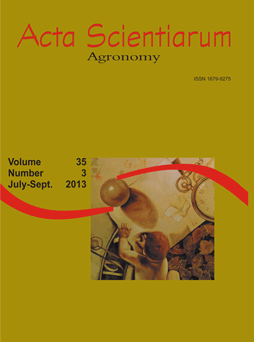<b>The management of cover plant residues for cotton cropped in a no-tillage system</b> - doi: 10.4025/actasciagron.v35i3.15294
Resumo
The cutting of plant residue in no-tillage systems under certain environmental conditions becomes necessary to adequately establish and grow crops. This study aims to assess the effect on the yield of different methods of managing millet plant residue in cotton plantations. The study was conducted during the agricultural years 2006/07 and 2007/08, and the treatments included no-mechanical-treatment tillage and the use of a rotary shredder, crimper-roller, and mechanical disintegrator for millet plants before sowing the cotton. Evaluations were performed for the residue fragmentation, emergence speed, percent of soil cover during the cycle and yield of the cotton crop. The emergence speed was faster in the management with the rotary shredder. In 2006/07, the no-tillage treatment showed a rate of loss for soil cover that was 46 percent greater than the disintegrator treatment. The rotary shredder and the disintegrator yielded greater soil coverage during the cultivation cycle, and the yield was highly correlated with the soil cover at 75 days after emergence. The management of the millet residue affected the cotton plants for the two-year study period.
Downloads
DECLARAÇÃO DE ORIGINALIDADE E DIREITOS AUTORAIS
Declaro que o presente artigo é original, não tendo sido submetido à publicação em qualquer outro periódico nacional ou internacional, quer seja em parte ou em sua totalidade.
Os direitos autorais pertencem exclusivamente aos autores. Os direitos de licenciamento utilizados pelo periódico é a licença Creative Commons Attribution 4.0 (CC BY 4.0): são permitidos o compartilhamento (cópia e distribuição do material em qualqer meio ou formato) e adaptação (remix, transformação e criação de material a partir do conteúdo assim licenciado para quaisquer fins, inclusive comerciais.
Recomenda-se a leitura desse link para maiores informações sobre o tema: fornecimento de créditos e referências de forma correta, entre outros detalhes cruciais para uso adequado do material licenciado.




















































